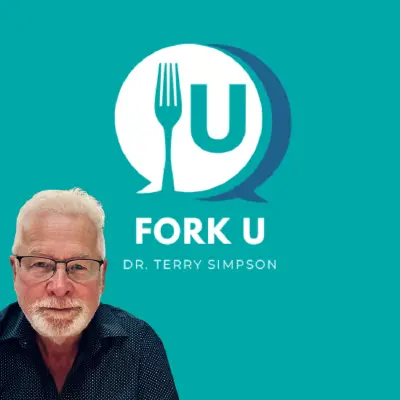Podcasts about Medicine
Episodes about Medicine
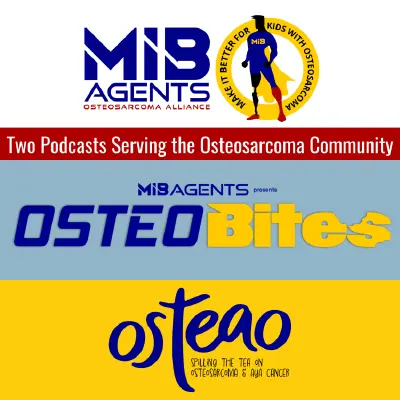
Jul 11, 2025
Old drugs, new tricks? A novel immunomodulatory approach to relapsed osteosarcoma therapy
MIB Agents OsteoBites and osTEAo ❭
Kelly Faulk, MD, a pediatric oncologist at Children's Hospital Colorado Center for Cancer and Blood Disorders, joins us on OsteoBites to review the open phase 1/1b clinical trial evaluating the combination of losartan and sunitinib in the treatment of pediatric and adult patients with relapsed or refractory osteosarcoma (NCT03900793), including preclinical rationale from canine clinical trials and the trial's design, eligibility, and status.Dr. Kelly Faulk is a pediatric oncologist at Children's Hospital Colorado Center for Cancer and Blood Disorders, where her clinical and research focus is the development of early-phase clinical trials to investigate promising new agents for high-risk pediatric cancers. She is on the Experimental Therapeutics Program (ETP) team and serves as the leader of the High-Risk Leukemia/Lymphoma Program. She has developed and leads several early-phase clinical trials and serves as site principal investigator for numerous others. She completed her medical training at the University of Colorado School of Medicine, did her pediatric residency and pediatric hematology/oncology/bone marrow transplant fellowship at Children's Hospital Colorado, and also completed an additional fellowship in Experimental Therapeutics at Children's Hospital Colorado. She met her wonderful husband Wade in medical school, and they have 3 great kids who keep them busy.

Jul 10, 2025
Ep 154: A 58-Year-Old Going for Surgery
Harrison's PodClass: Internal Medicine Cases and Board Prep ❭
Evaluation needed for a patient preparing for elective surgery.Read more on this topic in Harrison's.Harrison's Principles of Internal Medicine, 22nd Edition

Holy basil is a sacred plant in the Indian and Ayurvedic traditions. There is a wide range of conditions for which it is used, both physically and psychologically. Holy Basil is one of nature's panaceas, making it a powerful plant to grow in your garden and stock in your home. In today’s plant profile, you’ll discover: Holy Basil’s unique taste and how it supports your nervous, digestive, immune system, and more Holy Basil's unique combination of adaptogenic and nervine properties to support the modern stressed condition" Spiritual applications for this ancient herb Its relationship to Jupiter and the Fire Element How to prepare medicine with the fresh and dried plan ———————————— CONNECT WITH SAJAH AND WHITNEY ———————————— To get free in depth mini-courses and videos, visit our blog at: http://www.evolutionaryherbalism.com Get daily inspiration and plant wisdom on our Facebook and Instagram channels: http://www.facebook.com/EvolutionaryHerbalism https://www.instagram.com/evolutionary_herbalism/ Be sure to subscribe to our YouTube Channel: https://www.youtube.com/channel/UCyP63opAmcpIAQg1M9ShNSQ Get a free 5-week course when you buy a copy of the book, Evolutionary Herbalism: https://www.evolutionaryherbalism.com/evolutionary-herbalism-book/ ———————————— ABOUT THE PLANT PATH ———————————— The Plant Path is a window into the world of herbal medicine. With perspectives gleaned from traditional Western herbalism, Ayurveda, Chinese Medicine, Alchemy, Medical Astrology, and traditional cultures from around the world, The Plant Path provides unique insights, skills and strategies for the practice of true holistic herbalism. From clinical to spiritual perspectives, we don't just focus on what herbs are "good for," but rather who they are as intelligent beings, and how we can work with them to heal us physically and consciously evolve. ———————————— ABOUT SAJAH ———————————— Sajah Popham is the author of Evolutionary Herbalism and the founder of the School of Evolutionary Herbalism, where he trains herbalists in a holistic system of plant medicine that encompasses clinical Western herbalism, medical astrology, Ayurveda, and spagyric alchemy. His mission is to develop a comprehensive approach that balances the science and spirituality of plant medicine, focusing on using plants to heal and rejuvenate the body, clarify the mind, open the heart, and support the development of the soul. This is only achieved through understanding and working with the chemical, energetic, and spiritual properties of the plants. His teachings embody a heartfelt respect, honor and reverence for the vast intelligence of plants in a way that empowers us to look deeper into the nature of our medicines and ourselves. He lives on a homestead in the foothills of Mt. Baker Washington with his wife Whitney where he teaches, consults clients, and prepares spagyric herbal medicines. ———————————— WANT TO FEATURE US ON YOUR PODCAST? ———————————— If you’d like to interview Sajah or Whitney to be on your podcast, click here to fill out an interview request form.
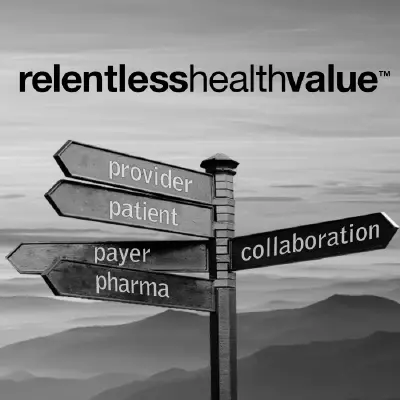
Jul 10, 2025
EP481: Seriously, IRL, What Does “No Margin, No Mission” Even Mean? With Benjamin Schwartz, MD, MBA
Relentless Health Value ❭
Balancing Mission and Margin in Healthcare: A Candid Conversation with Dr. Ben Schwartz In this episode, host Stacey Richter engages in a deep dive with Dr. Ben Schwartz to explore the phrase 'No Margin, No Mission' and its practical implications in the healthcare industry. They discuss the complex relationship between profitability and mission-driven care, the challenges of value-based care, and the role of dyad leadership. The episode emphasizes the importance of transparency, regulatory measures, and trust in fostering a balance between mission and margin. Along the way, Dr. Schwartz shares insights from his new role at Commons Clinic and addresses broader systemic issues like regulatory capture and the subjective nature of defining value in healthcare. === LINKS === 🔗 Show Notes with all mentioned links: https://relentlesshealthvalue.com/episodes ✉️ Enjoy this podcast? Subscribe to the free weekly newsletter: https://relentlesshealthvalue.com/join-the-relentless-tribe 🫙 Support the podcast with a small donation to the Tip Jar: https://relentlesshealthvalue.com/join-the-relentless-tribe 🎤 Listen on Apple Podcasts https://podcasts.apple.com/us/podcast/feed/id892082003?ls=1 🎤 Listen on Spotify https://open.spotify.com/show/6UjgzI7bScDrWvZEk2f46b 📺 Subscribe to our YouTube channel https://www.youtube.com/@RelentlessHealthValue === CONNECT WITH THE RHV TEAM === ✭ LinkedIn https://www.linkedin.com/company/relentless-health-value/ ✭ Threads https://www.threads.net/@relentlesshealthvalue/ ✭ Bluesky https://bsky.app/profile/relentleshealth.bsky.social ✭ X https://twitter.com/relentleshealth/ 08:50 Sister Irene Kraus and the origin of no margin, no mission. 10:01 Margin and mission versus profit and profiteering. 12:45 Stacey’s manifesto (EP400). 13:01 What is the broad mission within healthcare? 14:12 What is mission drift within healthcare? 15:54 EP474 with Yashaswini Singh, PhD. 17:26 Why do we struggle with balancing margin and mission? 20:47 EP455 with Beau Raymond, MD. 20:52 How does value vary? 23:18 EP326 with Rishi Wadhera, MD, MPP. 23:53 What needs to happen to balance margin with mission? 28:29 Why does everything come down to trust? 28:33 EP391 with Scott Conard, MD. 30:30 EP419 with Andreas Mang. 32:21 What are the “vectors of change” to create balance between mission and margin? 32:43 EP475 with Peter Hayes.
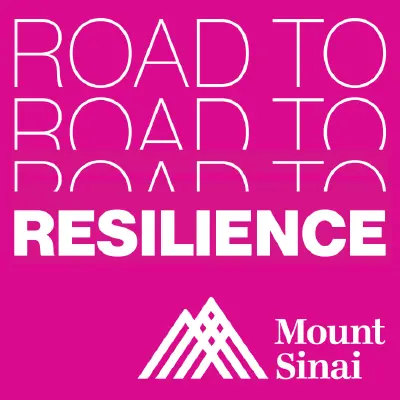
Godsfavour Guillet knows that healing goes both ways. As a nurse leader and caregiver, she’s helped innumerable patients and families, but also fellow nurses who needed support. Her story is deeply human and relatable, reminding us that resilience doesn’t mean shouldering it all alone.Visit https://www.mountsinai.org/clinical-trials to see if you're eligible to enroll in a clinical trial with the Mount Sinai Health System.Check out more episodes of Road to Resilience —as well as guest pictures, transcripts, and more— on the Mount Sinai website.Road to Resilience brings you stories and insights to help you thrive in a challenging world. From fighting burnout and trauma to building resilient families, we explore what’s possible when science meets the human spirit.
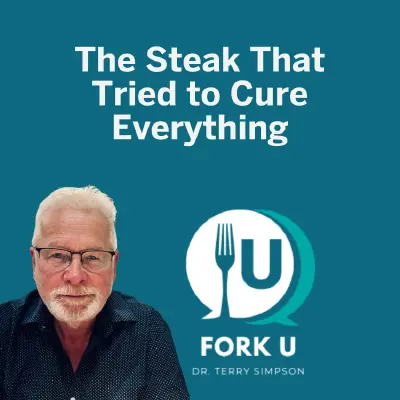
Who Was Dr. Salisbury?First, let’s meet the man behind the meat.Dr. James Henry Salisbury was a doctor during the American Civil War. He worked hard to understand why so many soldiers got sick. He noticed that stomach problems like diarrhea and dysentery were everywhere in the army camps.Because of this, he believed the problem came from food. But instead of looking at germs, he blamed vegetables.That’s right—he thought vegetables caused disease. To children everywhere, he became a hero. To science? Not so much.What Did He Believe?Dr. Salisbury believed that vegetables and starchy foods rotted in the gut. He said they caused inflammation and sickness. He thought the best way to stop disease was to eat meat—and only meat.So, he created a special food: the Salisbury steak.This steak wasn’t fancy. He ground up lean beef, shaped it into a patty, and told people to eat it three times a day. With it, they could drink only hot water or black coffee.No fruit.Absolutely no sugar.No grains.And definitely no vegetables.Why Did It Seem to Work?At first, some people felt better on the Salisbury diet. But why?Here’s the real reason: it wasn’t the meat. It was the boiling.Back then, most water carried bacteria. That bacteria caused all kinds of sickness. When soldiers boiled coffee, they accidentally killed the germs in the water. When they ate fully cooked meat, they avoided raw, dirty food.So yes, people improved. But not because vegetables were bad.They got better because boiled water and cooked meat killed bacteria.What Did He Get Wrong?Now, let’s talk about what he missed.❌ He didn’t understand germs or bacteria❌ He thought fiber was dangerous❌ He blamed plants, even though they weren’t the problem❌ He didn’t test his ideas—he just believed themHe meant well, but he built a health plan on the wrong cause.Instead of fixing the real issue, he created a food myth that lasted for years.Why Does This Still Matter?Even though Dr. Salisbury lived over 150 years ago, his ideas are back—on TikTok.Some people today say meat is the only healthy food. They avoid fruits, grains, and vegetables. They blame plants for everything from bloating to brain fog.Sound familiar?They’re repeating Salisbury’s mistake. They’re trusting old beliefs instead of new science.What Science Says NowLet’s be clear. Science today tells a different story.✅ Vegetables help your gut, heart, and brain✅ Fiber feeds healthy gut bacteria✅ A variety of foods lowers your risk of disease❌ Eating only meat can cause nutrient problems and long-term risksInstead of eating like it’s 1863, you can follow a plan that supports your body and your taste buds.The best example? The Mediterranean diet—with healthy fats, lean protein, vegetables, fruits, and yes… even a little red wine.In SummaryDr. Salisbury had a strong idea—but he missed the mark.He didn’t know about bacteria. He thought vegetables were the enemy. He gave us Salisbury steak, but also gave us a lasting food myth.So next time someone says vegetables cause disease, just smile and say: “We’ve been down that road. It was dusty, undercooked, and came
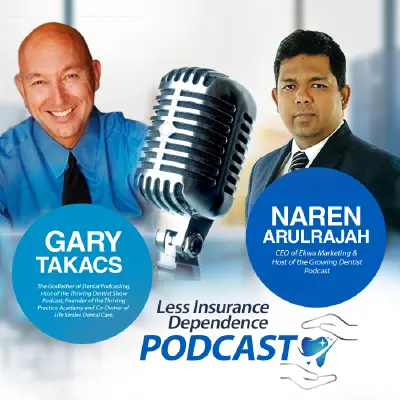
Jul 10, 2025
How to Become a 'Whistleblower' on Dental Insurance Companies?
Less Insurance Dependence Podcast ❭
Tired of getting the runaround from dental insurance companies?In this episode of the Less Insurance Dependence Podcast, Gary Takacs and Naren Arulrajah dive into one of the most empowering (and often misunderstood) topics in dentistry: how to stand up to insurance companies using the power of your state’s Insurance Commission. You’ll learn how to respond when you're told “we never received your claim,” what the 30-day “pay or respond” loophole really means, and why your patients, not you, hold the real power in filing complaints that insurance companies must answer to. Book your free marketing strategy meeting with Ekwa at your convenience. Plus, at the end of the session, get a free analysis report to find out where your practice stands online. It's our gift to you! https://www.lessinsurancedependence.com/marketing-strategy-meeting/ If you're looking to boost your case acceptance rates and enhance patient communication, you can schedule a Coaching Strategy Meeting with Gary Takacs. With his experience in helping practices thrive, Gary will work with you on personalized coaching, ensuring you and your team are prepared to present treatment plans confidently, offer financing options, and communicate the value of essential dental services. https://www.lessinsurancedependence.com/csm/

Confused about how much protein you should be eating each day? Registered Dietitian Michelle Schultz from Sarah Bush Lincoln, breaks it down for us. In a few words, keep it simple.Support the showSarah Bush Lincoln is a 150-bed, not-for-profit, regional health system located in East Central Illinois. Follow us on: Faceboook InstagramLinkedIn
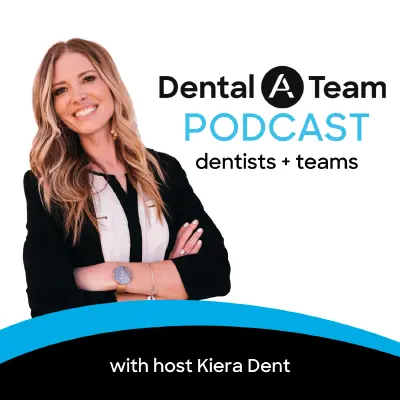
Re-releasing a DAT listener favorite! Dr. Lewis Chen is aboard the Dental A-Team! Dr. Chen has become an extremely successful dentist in a short amount of time — like, 10-practices-in-two-years successful. He shares with Kiera what he did differently to find his success, including utilizing the right resources and committing to a schedule. Dr. Chen and Kiera also discuss the difference between work and luck, things that went well, and pitfalls he wishes he’d avoided. He also shares life hacks, his best tip for delegation, and how to elevate teams. Episode resources: Subscribe to The Dental A-Team podcast Schedule a Practice Assessment Leave us a review Transcript: Kiera (00:05) Hey everyone, welcome to the Dental A Team podcast. I'm your host, Kiera Dent, and I had this crazy idea that maybe I could combine a doctor and a team member's perspective, because let's say dentistry can be a challenging profession with those two perspectives. I've been a dental assistant, treatment coordinator, scheduler, pillar, office manager, regional manager, practice owner, and I have a team of traveling consultants where we have traveled to over 165 different offices coaching teams. Yep, we don't just understand you, we are you. Kiera (00:14) Because face it. Kiera (00:34) Our mission is to positively impact the world of dental. And I believe that this podcast is the greatest way I can help elevate teams, grow VIP experiences, reduce stress, and create A-Teams. Welcome to the Dental A Team Podcast. ⁓ Team listeners, this is Kiera and you guys. Today is a pretty special day. I have a dear friend. We have chatted so many times. He is a rock star on Instagram. If you do not watch his channel, you definitely need to. And he's just one of the coolest people that I feel is a great inspiration. He's been able to do what a lot of other offices have not been able to do. So I'm so jazzed to bring on Dr. Louis Chen. How are you today, Louis? Dr. Chen (01:14) Good. Thanks for having me. It's always a pleasure. It's been so long since we've been actually meeting in person. think the last time was in 2018, 2019. Kiera (01:23) I Because I saw you I think first, was it Paul Goodman's event, the dental nachos? I think that's where we first met. Dr. Chen (01:30) Yeah, yeah, yeah. I mean, that's when I saw Mark in person for the first time and then I saw you for the first time, but I've known about both of you, you know, from some years back. So it's about time. Almost fangirling at the time. I'm fangirling now still. Kiera (01:43) So. Well, you're so kind. You just you inspire me. So I am so jazzed. Kind of take our listeners. I know a little bit of your journey, but gosh, you have done some impressive work since 2019, only in 2021. And in the middle, we had COVID. So kind of just walk our listeners through just your back history, your backstory of how you even got to being a dentist, what kind of inspired you to become one, where you're at today. Just kind of give people your quick bio on you. Dr. Chen (02:13) Quick bio, so okay, I'll give myself a short version. So I started in college with an economics major to which I graduated with that degree. And during that time in sophomore year, I remember interning at dental office and my parents liked the arts, liked the sciences, tried dentistry and I did. since that time, I shadowed a dentist and he was very, I was very shy guy. He's like, listen, you should spend some time learning about patient care. Just learn about patients. Don't think about the dentistry. Dentistry will come. go to school for that. School doesn't teach you how to speak to people. ⁓ then later I focused a lot of my time doing it. And I realized in New York City, the crux of New York City, dentistry is not cheap. It's an expensive commodity. part of that you when I sat there, realized like, you know, patients who've had a great time when they checked out, they had to build a pay, it's usually not as exciting. Kiera (03:21) It's true Dr. Chen (03:23) Yeah, so I had I was sought out on mission. said, well, you know, why in New York City is very saturated? Why should I be perpetuating that sort of, you know, that the stereotype of dentistry, dental work to be expensive? So I sought out a vision and said, you know what? I love dentistry. I want to provide good quality care. It's like, social hour, happy hour, every day, every hour. But why can I just make it a little bit more affordable? than my neighbor, neighboring dentists. And I wanted to provide exceptional patient experience and exceptional patient care, the dental care, so on and so forth, the whole camera things. And then I said, know what? I want to do on a scale. I want to at least have five offices by the time, and I want to achieve that. And I was 19 at the time. Kiera (04:13) Haven't even gone to dental school. You're like, here's the vision. This is what I want. And let's make it happen. Dr. Chen (04:18) Yeah, and that's exactly what I mean, through dental school, wasn't my vision. My vision was to be an exceptional provider, which is kind of still falls into my core values when I first started. purpose behind what I do is just, know, making, helping as many lives as, you know, impact as many lives as possible through this journey. then now fast forward, you know, I went to dental school, did right residency. And then 2019 to 2021, my partner and I which is who I met in dental school. was my professor at the time. And since then I've got all the new partners we just started to build and from two locations and now in 2021, hopefully by the end of 2021, we'll have 10. Kiera (05:02) You guys heard that right. That was 10. So, you know, 2019 to 2021, 10 practices. It's pretty impressive, Louis. And what I love, ⁓ you and I are very aligned. Our mission at Dental A Team is to positively impact the world of dentistry in the greatest way possible. And you also wanted to positively impact, ⁓ and change the way patients view dentistry. So I just love it. Louis, I think you're an inspiration to so many. So I'm going to like, let's get ready. Let's dive deep. Cause I'm sure people listening are like how. How did you do it? It like, that's great. You had a vision when you were 19, you went to dental school. Sounds like you partnered up with somebody fantastic. And now here you are two years later and you've got 10 practices. So kind of walk us through some of the things that you felt helped perpetuate that and make it into a reality. You're also in New York. I mean, you got hit hard with COVID. I think you actually were one of the hardest hit places of all. I mean, massive growth, massive, massive change. And you're also like real chill. You are always like, fun and engaging. also attend a ton of CE. You also have a personal life. So I'm a lot of people ask how and I'm always curious to know like very successful people, people who just I feel like and sometimes it's weird to say like successful people because you're like, I'm just Lewis, like I'm just this person. But it's like you do things differently. You are a different breed. Everybody else has the same opportunities in life, but you do things differently. So what are some of those things that you feel like you've done differently to get to this state in your life right now? Kiera (06:18) Your Dr. Chen (06:29) That was a loaded Kiera (06:30) It is a loaded question. That's why you're on the podcast, Louis. You can ask all the questions to you. Dr. Chen (06:33) I You asked amazing questions. I'm happy to entertain and I feel like I should be a better question asker too. To start, think to perpetuate is one is having the proper resources available to you and just committing yourself. I remember when I was in residency or whatnot, on top of being in residency, learning what I had to do and just kind of self-learning. I was listening to lot of podcasts and then eventually podcast was a huge learning experience because it's available. It's available and why not utilize it? Over time as you start building your sort of operations business, I entertain, you know, just taking CEF. Actually, one of my team members, couple of my teams are infatuated with you, Kiera, by the way. They love you. They're like, Oh my God, I wish I could be Kiera. I'm like, you should. Kiera (07:19) When I come to New York, I'll be there in December, let me know, we'll hang out, be a time. It'd be a fun surprise list, we should definitely like off air, come up with a surprise, it'd be real fun. Dr. Chen (07:30) Yeah, it's it's it's I do send a lot of information you send out to your newsletters are fantastic. So again, actually reading the resources are provided. I know sometimes people just kind of sift through and kind of toss it away. But I should sift through it and I say, well, I'm going to forward to the appropriate team members so I can elevate them. Right. So one of the just, you know, being the good filter of resources is one of what you do is committing yourself to a schedule. Right. For me, like I'm always an early bird now, like 5 to 35, 45 wake up. I work pretty much all day, like nonstop and it's hard to get a hold of me. I'm always bouncing around offices. And I what gets me going is really just that commitment to purpose, which I think that people don't focus so much on. And when they go into dentistry, it's that purpose. I still stand by what I want to achieve when I was 19 till now, which is basically just continue to drive and push for great, great things, you know, and over time it, you elevate yourself. and you realize you just start to grow in size, expand, you need to have a belief system. And it comes first, which is, know, what's your core values and really just redesigning everything that you do. So ⁓ that gets me going. I wake up in the morning, I have a purpose behind what I do. ⁓ I have my own personal core values that I abide by. ⁓ And there's nothing better than that. Kiera (08:51) I love it. I love it so much. And Lewis, of course, I'm going to dive in deeper. think a few pieces I pulled from that is one, it sounds like you're very, ⁓ let's say like regimated, like, you know what you want to do in life. And I found that when I talked to successful people, it's one of my favorite things about the podcast is picking people's brains. ⁓ Tony Robbins has a quote that I love and it says successful people ask better questions. So it's like, what is that routine? Like you have a morning routine, you wake up at certain times, you're very much dedicated to a purpose, something beyond you. Because like when those hard days come, which they will always come, it's pulling back to why are we doing this? What is the why behind it? So I love that you, started first with that. I also love that you mentioned you filter through the resources that are available. You're right. This podcast is free. Like people can download it, listen to it. We put it on for free and we bring on really awesome guests. also like our newsletters are written by our consultants and I check all of them, make sure there's awesome facts, tangibles in there. It's not just a newsletter of like But it really is, but also filtering through like what is that best information? So I love hearing that you actually take the time to read through it. Be systematized in how you operate. So I'm going to dive into like, what do you feel? Cause I feel like I was given the golden spoon of success meeting Mark Costas. Like I will say that again and again and again, just like proximity is power, right place, right time meeting people I connected in, I helped an office grow exponentially. They connected me with Mark Costas, had the whole DSI experience. It was amazing. Kiera (09:56) but you're also very Kiera (10:18) perpetuated Dental A Team, learned a ton, but like that was a strike of lightning, but I don't think it was just pure luck. think right place, right time, also looking for opportunities. So for you, what were some of those opportunities again, cause I hate when people say it was just luck. I'm like, yes, did I get a really lucky golden card out of heaven? Absolutely yes. But I also think there was a lot of preparation that came for it. So what were some of the things you feel like you've been, you've done well that has kind of propelled you to be able to do 10 practices in two years? Dr. Chen (10:46) To your point, know, like I do say it's a part of luck, but I think it's a little bit of understanding whether the luck is presented to you. Because sometimes people, there's plenty of opportunities that presented it. And sometimes we just don't visualize it to be a luck. know, for me, I was really hard. You I worked hard and I graduated early from dental school, but I was the only guy who worked till the very, very end. Even though didn't have to, I still wanted to work. didn't take the vacation that other people did. I just really wanted to be the absolute best at what I did and be comfortable with it. And my partner at the time, my professor at the time is a prosthodontist. So he's very detail oriented. He had his eyes on me, like this hard worker, great with people, loved dentistry, good clinician. And I had a vision, know, him and I sat down and he said, what are your goals? Because he wanted to hire me as an associate. What are your goals? What do you want to do? And then as soon as we got off that dinner, I remember it was December 2016, something like that. He was just like, what if I want you to work with me? Like not just work with me, like work, build something with me. I'm like, what's going on? And I didn't went to residency and I was like, all right, cool. I'll continue to do what I had to do. ⁓ But I continued to revisit and commit to my, that luck and opportunity. ⁓ Again, I think to that point, I think we have to understand that we have to our best self out for us every day because if you're not performing optimally, yeah, sometimes people perceive, you know, under performance is not optimal performance. And I'm going to deliver, you know, if an interview falls short, you know, like what I have to do, that's the first impression, right? ⁓ So I definitely think that we have to be on A game all the time for sure in order to, and then... Once you hit that point, critical mass like a games always your game. Kiera (12:38) That becomes your new standard. That's where it is. That's your baseline. Dr. Chen (12:41) That's the baseline. Did I answer your question, Tyler? There's another loaded question. So I was like, Kiera (12:46) It was a loaded question, Lewis. I just like to pick people's brains of like what it sounds like if I were to recap it in a way, it's almost as if I feel like you put in a lot of hard work, hustle and grit. And I think that that's important. I love the picture. I'm sure a lot of us have seen it of the ballet slippers. Like there is a ballerina on point and one foot's in the ballerina slipper and the other foot is this like cut up bloody hot mess. And it says everybody wants success, but they often don't realize what it takes to get there. And I think about, like, I just heard a lot of that hard work, that grit. You also had a vision and you were very committed to it. So I think about team members, I think about practice owners of what is that vision and are you actually committed to it? Are you a fair weather fan or are you like ride or die? I will achieve this goal. And I hear a lot of conviction, but also because of that conviction from you, Louis, I feel like it also presented you opportunities that might have otherwise passed you by. This professor was looking for an associate. ⁓ You had proven yourself to be this very successful student. So they were looking, there was an opportunity sitting there. You didn't even know it. I tell people often, I groom people. I watch people before they even become in leadership. My husband was groomed for about four years before he was taken into leadership. Had no idea it was happening, but people are constantly watching. There are opportunities always around us. It's just, like you said, who are you presenting day in and day out? So I love that. I love that. Kiera (13:51) And a lot of times I Kiera (14:11) And I hope other people are listening and realizing it's not just a stroke of luck. Being your best self, having that baseline continually, that's what's gonna set you up for opportunities that you may have otherwise missed. next up, professor, decide you're going to become partners. You're gonna take this on, you finish up residency. So I also love that you equipped yourself with the skills and tools you needed. So if it didn't work out with your professor, all eggs were in that basket. You're like, with you or without you, I will do this. And I like that you did that. Kiera (14:15) It is literally. You and Kiera (14:40) So then what are some of the things you felt you and your partner did very well from the get go? Cause I also feel a lot of success comes from pivoting quickly, learning from your mistakes very quickly. So what were some of the things you felt at the beginning you guys did really, really well, and then I'm going to pivot to mistakes. But right now, what are some of the things you felt like that set me up for success exceptionally well in the beginning? Dr. Chen (15:03) Well, I think they keep an open mind and think that having the clear expectations of one of each other is important. As we continue to grow, we add more to partners too. We've been again, it's awesome to have different. we, we, we may get very clear what our strengths are, stay in your lane kind of thing. My partner is great with the financial aspects. I'm great with, well, I'm not great with system, but I like systems. Kiera (15:26) I can tell you wake up at a certain time, the process, I got the vision, you're good. Dr. Chen (15:30) Yeah, the gaining writing it, the process, the system, putting it in place, organize, that's the hard part that he doesn't take care of. But that's what I do. The one thing that we did do well is we talked about where we want to what we want to achieve. I think that one of the things that he mentioned was, you know, what he's trying to achieve is not, you know, for the financial goals. His is very in line with mine, which is to provide exceptional care. So our core values were aligned. So at any given point. I just know the decision that he suggests and makes ⁓ is for better, for good purpose or for the right reasons, not for any other intent. That was really important to us. ⁓ of course, you know, just building a lot of trust. I did throw a lot of my eggs in his back. And in fact, I did, threw everything in. have nothing. All my trust is all in. and, be, you know, be, be have the conviction to finish and, and strong. And that's kind of where we stood. And I think that's what we did well. And we continued to grow. We weren't stagnant. We all, like my partner, he's 10 years my senior. So he's constantly in leadership classes because he needs to be a better leader. He wants to be a better leader. He takes the necessary classes to be a better leader. He understands he's self-reflective and self-aware about how he presents himself to his team. And it rubs off on me. again, we learn ⁓ one also great thing is we embrace honest mistakes. We embrace the humility. Cause even if I made a mistake and I would, I would honestly tell them like, cause I'm looking my bad. I didn't think about this. I didn't think about that. Here's the outcomes. Like it's fine. Just, just don't do it again. Just figure it out. Put it on a sheet of paper, figure it out, do it again. And ⁓ that's, there's a lot of forgiveness in that process, which helped. I oftentimes think that if there's no open communication to allow for humility, ⁓ people get, you know, they're probably get stuck with within their own confines. ⁓ And I think that's something that was really beneficial for us. Kiera (17:38) As you guys look back on 2021, how was it? Was it your best year? Was it a year you could have done a little better? And as you're looking forward to 2022, what type of a practice and a person do you want to be? Well, guys, now is the time to take massive action and to have the life and the practice you've always wanted. Dental A Team Platinum is where it's at, guys. We focus on system development. That's right, top to bottom. Team development, growing leaders, growing you as a person, making sure you're balanced, that we have happier teams. And we also ensure that your practice is profitable, teaching you how to be business. So if you're looking to enhance your practice, take it to the next level. You yourself want to grow. Now is the time. Dental A Team platinum. We fly to your practice. Most of our offices see a 10 to 30 % increase in revenue, reduction of stress, happier teams, better patient experiences. So if you know, you want to rocket launch yourself into 2022, don't wait guys. We are only taking on so many platinum practices because we physically fly to you. So email us today. Kiera (18:09) Abby. Kiera (18:34) Hello@TheDentalATeam.com and you better believe we have something special for you end of year offices. So be sure to reach out Hello@TheDentalATeam.com. Remember you're only one decision away from a completely different light. Kiera (18:37) So Gosh, so many good takeaways because I think so many people have partnerships that actually don't go well. And so helping to see you guys were in your lanes, you also had complimentary skillsets to one another. I think that that's actually amazing that you figured out stay in your lanes. And then there's the honest mistakes, like that happens. I tell everybody like fail successfully. And I also love another quote, like there are no failures. There's just results. Like what happened? Why did it happen? Like let's learn from it so it doesn't happen again and move forward. And when teams and partners feel that they can make those mistakes, there's so much freedom. Like the rules and the boundaries are all open. You can have anything. There's massive creative success and openings and ideas that can come because you feel very, very free, I guess, to make those mistakes. You know you're gonna be accountable to it, but there's nothing wrong in not having it go exactly as planned. So I'm not gonna pivot, Louis. Like you've been so generous. And I just, wanted to pick your brain. I've been dying to talk to you. You guys have such a fun culture. which I think kudos to you guys for doing that. But now next up is going to be, what do you feel, like I know I can go back in my career and say like, these were big pivotal mistakes that if I could do it over again, I would never have done that. So maybe one or two of those, and not even mistakes, I guess it's just like, like of course I learned from them. I'm grateful I had them, but if I was giving someone guidance, these would be some pitfalls that I wish I would have known about prior to making them. Do you have any of those that have come? I mean, 10 practices in two years, Louis, I'm not gonna lie. Like it's impressive. I love it, I'm so freaking proud of you. I'm like high fiving you through the screen right now. Just impressed with who you are and that your vision's coming to light. What were some of those pitfalls though that you're like, wish I would have done that. Dr. Chen (20:25) I couldn't, there was a laundry list and to your point of failing successfully, so important failing forward. I mean, God, like it's, can give you a whole separate podcast on just fail failures. Biggest thing is, Eagle let go of Eagle. Huge thing about Ventus is Eagle. It's like, it go. Number two, team culture. number three, put the, pro provided proper resources for success. you know, seek out, there's tons of resources out there. Like you said, you can. Kiera (20:27) Ha Dr. Chen (20:55) You can purchase the protocols, can purchase manuals, can, you know, whatever it is, you don't have to reinvent the wheel if you don't have to. Very simple, right? And oftentimes people think I want my own recipe. And I always say it, I say it to my teams. I'm like, at some point, re-revent the recipe, you know, the wheel, or just follow, always following someone else's recipe. Use the recipe to make something that you like to cook, not what they like to cook. If you want that breaded chicken, maybe you want some breaded cutlet chicken cutlet with some other paprika or something like, or Cajun. That's your recipe. What are those additional variables? But you don't have to reinvent the wheel, save yourself the time and struggle. ⁓ Number three is learning to elevate the team. I realized that people forget that every team member is looking for growth. You just have to provide that platform for growth. Another one is, again, same thing with race humility about your leadership. I think that sometimes people look for team members with skillset and they don't provide the opportunity to look at potential more than skillset. And to this day, I don't hire for skills. I hire for talent to hire for potential because you can't find someone who's really good with hospitality, who hasn't been in the hospitality. Kiera (22:05) Amen. true. So true. I love it. Dr. Chen (22:09) Yeah, there's so much more to things that I, ⁓ again, even cultural alignment with your partners, resetting that, having that conversation or revisiting, you figuring the differences out that, know, the only way you can grow is to be aligned and there's no other question. There's no other way around it. Kiera (22:27) Gosh, I love it so much. think that there's just so many pieces on there. And something I really wanted to highlight, the reason I asked that question is because again, I think so many people look at that and say, my gosh, 10 practices in two years. Is this person really human? Do they ever make mistakes? And I think it's really important to realize on the path of success. I loved, heard a quote and it's called the success tax. Like there are hard times that follow. There are things that we wish we wouldn't have done. There are things that we learn along the way, but it's like, just keep growing and becoming better. So I'm actually gonna ask you, I came up with a few questions that I've wanted to ask podcast guests that I'm like, ⁓ I'm gonna remember to ask Louis these. So my first question is, what is your best time saving hack? Dr. Chen (23:12) time-saving hack. People oftentimes say it's because I sleep so little. Kiera (23:17) How many how many hours do you sleep at night Louis let's talk about that Dr. Chen (23:21) So I got an aura ring. So this is a ring that measures your sleep and the REM sleep. So I'm trying to life hack myself through data by understanding like, well, if I'm, if I'm getting X amount of hours of deep sleep or REM sleep or whatnot, am I going to, do I wake up feeling like I'm going to be productive? Right. I feel like I'm energized. Do I feel like I'm putting myself, you know, put my best foot forward? That's key. I am huge on calendars. I know that I heard a podcast on productivity. Some people say to do lists are great, but calendars even better, but I personally have all my work that I do actually on calendar by blocks almost. I put it on my calendar to say, all right, today payroll, got to do payroll. Not that I hope to achieve it, but there's so many moving parts that what time set forth is not usually the time I will take to complete. at the minimum, I try to tackle it by, I have a to-do project management to-do list and I break it down by location, by management, by, you know, team members or administrative or all that stuff. And I prioritize it based off deadlines. So for me, I feel like I will prioritize and provide a deadline for myself if I find this work's gonna take a little longer. If it's easy, I'm not gonna get out because there's no point to delay procrastinating easy tasks because I feel like completing easy tasks, tasks drive, provides us momentum and inertia to continue to achieve more. So sometimes I wake up waking in the morning, like tackling the biggest task and like, this is a drag. gonna take a long time to do it. But if I just start tacking like, you know, just, you know, finishing off some emails or just, you know, taking off some of the things on the to-do list, I get this momentum of feeling pro tip productive and I continue to be more productive. ⁓ but that's one of my life hacks. Kiera (25:03) I like it. I like it. Okay. So I like also that you, one thing I hope people are picking up is that you innovate. You are literally looking at your sleep habits to see do, could I actually be as productive with less sleep? Like I love it. I love that you're testing it out. You're trying it out here. Like you think outside the box and I really hope that people are realizing like it doesn't just come with like the flick of your wrist or you know, a magic wand. Like this is called, you're actually putting these things into play. also agree with you. Calendaring. It is a world of difference like I literally put blocks on the calendar because if there aren't blocks I've got an hour or two of free time Well instantly that hour or two gets sucked up by all these other things because I didn't actually proactively take care of it. So awesome next question is What's your best tip for delegation? And this is me just selfishly asking you all the things I want to get better at So I'm just asking this is you and me having a private podcast more for myself. So best tip for delegation. Louis. What is it? Dr. Chen (25:58) I think the best question that that question I should be asking you instead, because you've been you've been able to grow practices, you're in consult now. So like, delegation is a weird thing. I think everyone says it the same, you everyone says the same thing. Abdication is very, very different delegation. Abdication is really just kind of relieving yourself of the work that you don't want to achieve. And it's putting into hands of someone with autonomy and then not providing the outcomes that you find to be successful. ⁓ Delegation is understanding that your productivity will increase by you offloading some of the workload. So you can spearhead the delegation, not to do the work, but you can provide projects or spearhead, you know, with an individual who can take the load off and understanding an agenda. Even for myself right now, I'm at the point where I need to hire some more HR recruiters and more operations team members. And I know what I need because my time is diminished if I continue to focus on so many different things that I know I can offload and just oversee, have a project timeline for that. Kiera (27:06) Totally. I love it. I also, like, as you said that I'm hoping people heard that you prioritize your time and you're constantly hiring and innovating and bringing on different people. So that way you're always on optimum peak performance. Like what are the things that only you can do? Times being diminished. I could outsource this. I could hire somebody else. So, ⁓ and then the last question I have for you is your best tip for like team communication, or you talked a lot about elevating your team. This is a team podcast. What is something that you feel you do really, really well? I think you guys have a really fun culture from what I see, super jazz for what you guys are doing. What do you feel is something that you've done very well to help have a great team culture in your practices? Dr. Chen (27:46) So when I, and I still do the HR, so I hire for, I hire every person. And one of the biggest things is me being the person who can establish that culture through the interview from the get-go because, that comes from speaking to if with the right candidate, ⁓ I spend a little bit more time really going through the company culture as well as the core values of the, of the, of the office. So this way they come in expecting that what's harder is kind of shaking up the culture that doesn't exist. Basically trying to create something that didn't start. like every office I'm trying something new, like find you the new Peto office that my partners and I have, you know, I came in and did this whole cultural thing and I'm not great at it. I'm trying it, but I walk in, I feel amazing. You know, I feel amazing. I see the team, the team is great. I feel I can't wait. I love coming to the office, right? And I love knowing that I can, because I also know that the team loves that too. ⁓ So that's one thing is to create the culture is just establish it from the get go. Like do not this do not delay the process to onboarding. If the moment you get onboarded culture comes first the belief systems. ⁓ Another thing is, you know, being honest with yourself with that process because it's very it's corny. And everyone talks about no one no one is like when I first started like core values, what are those like this work needs to be done right? Totally. realize that toxicity happens and there's other stuff that needs to be managed and navigated. And it's just so much harder if you don't, especially if you start growing, the culture has to be consistent across the board. So yeah, and it's easier with one because you see the same people all the time. But if you're drop shipping yourself in different locations, you expect the culture to persist. And am I great at it? I am far from it. And I'm constantly, even right now, I'm just trying to figure out how do I measure culture, right? How do I ensure that it's being consistent? Maybe because I'm coming in, people are performing well, maybe they're not, right? And how do I measure that? That's being, that's, I think that's the first and foremost thing. Kiera (29:59) I really love that you said that and I love that you said it's cheesy because I think so many people think it's cheesy so they actually don't do it. And yet at the end of the day, we've got great resignation. It's hard to hire all these different pieces, but I'm like, you clearly are hiring a lot of people. And I think having a great culture that people genuinely love to work there. Having a culture that is based on core values. I have redone my core values. I think we're on like rendition four, but it's because I realized like things are being missed from our company. And so I love that you brought up like the cheesy aspect of it. So bottom line is, and then you ask, and I'm actually just going to give you a tip that I've heard for how do you measure culture? Cause you're right. Like it should be a tangible thing. should be something when we walk in, it is the same from practice to practice to practice. So an office that I really, really love and respect and admire, they actually send out quarterly surveys or twice a year surveys. So November and May, and they actually have an anonymous survey of like, how is the culture? So they get a pulse on all the practices. ⁓ For my team, I'm constantly ripping our core values down and I will spot audit them and say, all right guys, what are our core values? And I will randomly ask different people on calls just to see, do they know the core values? Having core value shout outs at morning huddle where they have to all choose a team member and pick a core value. I don't care which one it is that exemplifies that. it'd be like today, Dr. Chen, I'm going to give him the core value of fun. Like he's always fun. He brings a lot of fun energy. So it actually is infused into your practice. but then how to measure it doing those quarter or those twice a year surveys oftentimes can give you kind of a anonymous pulse on your practices. So I love that you brought these pieces in. I love that you're focused on it because I really do believe great cultures are where great practices are able to impact their community stronger. And it also impacts the lives of those that work there. So I love it. Those are so fun, Lewis. think it's fun to see your journey. It's been fun to watch you grow. Kiera (31:40) this is happened. Kiera (31:51) I I met you pre even owning practices and now to see you where you are and I just know there's so much more ahead of you. So I love it. I'm always rooting you on always happy to help. We should definitely plan a time to meet up. I'm always in New York. So I'd love to see you guys, but ⁓ thanks for sharing. Thanks for sharing all your tips. Any, any last things you want to share as we wrap up? I'd love to hear anything else you want to add in. Dr. Chen (32:13) I think to any team member or any provider, particularly the providers, because to grow, you have to keep an open mind to what's out there. And even for myself, like you mentioned, I do say it's cheesy, but no one talks about it. But you know what? I see the difference day and night. It changes the way you deliver your care, it the way you lead, it changes the way you manage. And to your point, I tried the team surveys. Again, I like trying a lot of things. And I realized that sometimes trying things has to have a structure. when you're ready for it, like I couldn't measure culture if I didn't understand what culture meant. But now that I have culture set in court, the core values of company culture established, now this might have a better impact. Now I have team members who can understand that and deliver that. So it is requires a lot of step back. I think one thing to learn from any team member is like, take a step back and just kind of take a read on the practice. Whether people are feeling great, there, you know, I like, I like Danny Meyer. Danny Meyer, is podcast I sent it to you. And he talks about having team members, you know, check the weather report before to come in. Because if you're feeling sunny, there's going to be a sunny day in the office, patients, team members, everyone. But if you're feeling like you have a rainy day, you check yourself, leave that rain behind because you're going to rain on everyone else. So that's one thing that I've started to realize is I gotta make sure to check on my Retherport every single day before I deliver my results. Kiera (33:46) That's awesome, Lewis. You are just like I said, an inspiration. It's fun. Thank you for sharing. know it's sometimes uncomfortable to share our successes, sometimes uncomfortable to share failures. But I just love that's why I love this podcast because we bring the best of the best. We share ideas because I think sometimes just hearing someone's story, hearing someone's experiences, learning from them helps rocket launch so many other practices to success. So thank you, Lewis. I just adore you. I'm so glad you're here today. Always cheering you on. So thank you. Thanks for being a part of this today. Dr. Chen (34:15) Thank you, appreciate it. Kiera (34:17) Of course. All right, you guys that wraps it up. Dr. Lewis Chen, super grateful guys. If you check him out, he's all over social media. ⁓ great, great person. He will respond to you. Like you will never believe this man is as busy as he is because he responds all the time. He's always gathering so much information. So check him out. Such an inspiration. And as always to all of you, thank you for listening and I'll catch you next time on the Dental A Team podcast. That wraps it up for another episode of Dental A Team Podcast. Thank for listening and we'll talk to you next time. Kiera (34:44) Thank you so much for
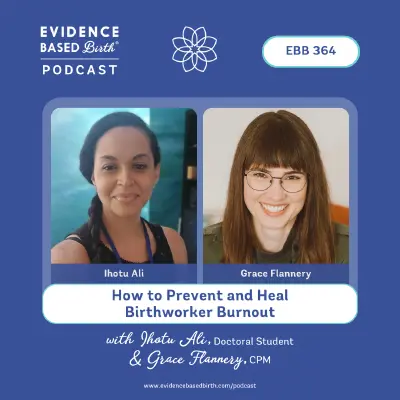
Jul 09, 2025
EBB 364 - How to Prevent and Heal Birthworker Burnout with Doctoral Student Ihotu Ali and Grace Flannery, Certified Professional Midwife
Evidence Based Birth® ❭
Licensed community midwife Grace Flannery and doctoral student Ihotu Ali, founder of the Oshun Center for Intercultural Healing, join Dr. Rebecca Dekker for a moving conversation about burnout, boundaries, and building sustainable birth work. Together, they explore the root causes of burnout in maternity care, from systemic extraction to internalized pressure, and how the path to healing lies in slowing down, reconnecting with purpose, and redefining productivity. Ihotu and Grace share the origin of their collaboration through the Sweetwater Alliance, the transformative “One Main Thing” meditation, and their four-part framework for reclaiming balance: Seasons, Smallify, Support, and Spirit. This episode is a heartfelt invitation to anyone holding space for others while feeling the weight of burnout. (04:27) Grace and Ihotu’s Birth Work Journey (07:54) The Roots of Burnout in Maternity Care (13:19) Presence, Boundaries, and the Burnout Cycle (18:33) Symptoms and Signs of Burnout (27:06) The “Four S’s” Framework for Sustainable Practice (30:08) Accountability, Rest, and Seasonal Rhythms (38:21) The “One Main Thing” Meditation Practice (44:28) Reconnecting with Purpose and Capacity (58:51) Final Reflections on Slowing Down and Healing To sign up for the EBB Summer Series, visit ebbirth.com/summer! Resources Learn more about the Oshun Center: oshuncenter.com Follow Ihotu on Instagram: @ihotuali Learn more about Trillium Midwifery Care: trilliummidwives.com Follow Grace on Instagram: @midwifegracef For a full list of resources, including links to the free One Main Thing Meditation, visit ebbirth.com. For more information about Evidence Based Birth® and a crash course on evidence based care, visit www.ebbirth.com. Follow us on Instagram and YouTube! Ready to learn more? Grab an EBB Podcast Listening Guide or read Dr. Dekker's book, "Babies Are Not Pizzas: They're Born, Not Delivered!" If you want to get involved at EBB, join our Professional membership (scholarship options available) and get on the wait list for our EBB Instructor program. Find an EBB Instructor here, and click here to learn more about the EBB Childbirth Class.

